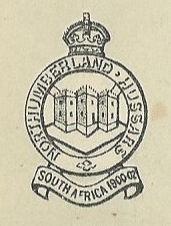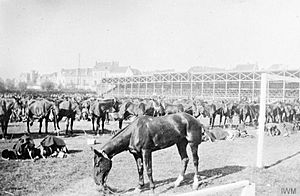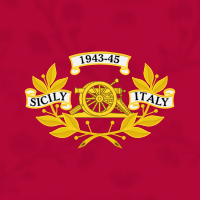Northumberland Hussars facts for kids
Quick facts for kids Northumberland Hussars |
|
|---|---|

Cap badge
|
|
| Active | 1819–present |
| Country | |
| Branch | |
| Type | Yeomanry |
| Role | Formation reconnaissance |
| Size | One Squadron |
| Part of | Royal Armoured Corps |
| Garrison/HQ | Newcastle upon Tyne |
| Nickname(s) | The Noodles |
| Engagements | Second Boer War First World War
|
| Battle honours | See battle honours below |
| Commanders | |
| Honorary Colonel | Captain Nigel R. Wyrley-Birch, TD |
| Notable commanders |
Charles Loftus Bates |
The Northumberland Hussars was a special cavalry unit in the British Army. It was part of the Yeomanry, which were volunteer soldiers who rode horses. During the Second World War, they became part of the Royal Artillery, which uses big guns.
The unit was later disbanded in 1967. However, its name lives on! Today, a squadron (a small group of soldiers) in the Queen's Own Yeomanry is called the Northumberland Hussars. This squadron is based in Newcastle upon Tyne and helps with scouting and finding out what the enemy is doing.
Contents
History of the Northumberland Hussars
How the unit started
In 1794, Britain faced a big threat from France. King George III and Prime Minister William Pitt the Younger wanted to protect the country. They asked counties to form volunteer cavalry units. These units would defend against invasion or help control public unrest.
The Newcastle Regiment of Yeomanry Cavalry was formed in 1819. In 1831, this unit helped stop miners' strikes. An Army Riding School was set up in Newcastle in 1849 for the regiment to train. In 1876, the unit was renamed the Northumberland (Hussars) Yeomanry Cavalry.
Fighting in the Second Boer War
The Yeomanry units were usually for home defense. But in 1899, Britain needed more soldiers for the Second Boer War in South Africa. The government asked volunteer units to send soldiers overseas.
The Northumberland Hussars sent several companies (groups of about 115 men) to fight. These soldiers were trained as Mounted infantry, meaning they rode horses but fought on foot. This new way of fighting worked well. Because of their success, the regiment was called the Northumberland Imperial Yeomanry (Hussars) from 1901 to 1908.
The First World War
When the First World War began in 1914, many Yeomanry soldiers volunteered to fight overseas. So, units were split into "1st Line" (for overseas service) and "2nd Line" (for home defense). A "3rd Line" was also formed to train new soldiers.
1st Line Northumberland Hussars
The 1st Line regiment was ready for war in August 1914. They went to Zeebrugge in Belgium in October. In April 1915, the regiment was split up. Its different squadrons (smaller groups of cavalry) joined different infantry divisions.
In May 1916, the squadrons came back together in France. They served as the cavalry unit for various Corps (large military groups) until the war ended in 1918.
2nd Line Northumberland Hussars
The 2nd Line regiment was formed in October 1914. In April 1916, it also split up, with squadrons joining different divisions or operating alone.
In February 1917, the regiment reunited and moved to France. It was the only 2nd Line Yeomanry regiment to serve overseas in the First World War. Later, in September 1917, it joined with the Northumberland Fusiliers infantry unit. It was then known as the 9th (Northumberland Hussars) Battalion, Northumberland Fusiliers.
3rd Line Northumberland Hussars
The 3rd Line regiment was formed in February 1915. Its job was to train new soldiers. In January 1917, it became part of a larger reserve cavalry regiment.
Menin Gate Memorial
The Menin Gate is a memorial in Belgium for soldiers who died in the First World War and have no known grave. Four Northumberland Hussars soldiers are remembered there. A fifth soldier was added to the memorial in 2017.
Between the World Wars
After the First World War, leaders realized that cavalry (soldiers on horseback) were not as important anymore. Many Yeomanry regiments were changed. Some became armored car units, and many became artillery units.
The Northumberland Hussars was one of the few regiments that remained as a horsed cavalry unit for a while. This was because it was one of the oldest and most respected Yeomanry regiments.
The Second World War
In February 1940, the regiment changed again. It became part of the Royal Artillery and was called the 102nd Light Anti-Aircraft and Anti-Tank Regiment, RA (Northumberland Hussars). This meant they used guns to fight enemy tanks and aircraft.
In October 1940, the regiment sailed to the Middle East. They changed their setup to focus more on anti-tank guns. In April 1941, they went to Greece to help with Operation Lustre. They had 578 men, 168 vehicles, and 48 anti-tank guns.
In Greece, they fought bravely against German tanks and planes. They helped protect the retreat of Allied forces. After a long battle and march, they reached Athens and were evacuated. Many soldiers went to the island of Crete.
On Crete, they fought as infantry (foot soldiers) against German paratroopers and gliders. They had to retreat across mountains to be evacuated. Many soldiers made it, but over 200 were left behind and had to surrender.
After returning to Egypt, the regiment got new equipment and more soldiers. They joined the 7th Armoured Division for Operation Crusader in November 1941. They also fought in the Battle of Gazala and the Second Battle of El Alamein in North Africa. Later, they fought in Sicily.
In October 1943, the regiment returned to England. They were very experienced, having fought in six major battles. They were chosen to be part of Operation Overlord, the D-Day invasion. For six months, they trained for the attack on France.
For D-Day, the Northumberland Hussars used special anti-tank guns and M10 tank destroyers. They landed on Gold Beach in Normandy on D-Day, June 6, 1944. They helped support the infantry brigades as they pushed inland.
The 50th Infantry Division, which included the Northumberland Hussars, did very well in Normandy. They were a key part of the British advance. The regiment stayed in Northern Europe until the end of the war.
After the Second World War
After the war, in 1946, the regiment returned to its original role as a Yeomanry unit. They were equipped with Cruiser Tanks for scouting.
In 1967, the British Army made changes to its volunteer forces. The Northumberland Hussars was reduced in size. However, in 1971, the unit was reformed as part of the Queen's Own Yeomanry. They used Ferret and Alvis Saracen armored cars.
Over the years, the unit continued to change its equipment, using Fox armoured reconnaissance vehicles, CVR(T) Sabre, and FV107 Scimitar vehicles. Since 2014, they have been equipped with Land Rover RWMIK vehicles. Today, they are known as the Command and Support Squadron (The Northumberland Hussars) within the Queen's Own Yeomanry.
Regimental museum
You can learn more about the Northumberland Hussars at the Discovery Museum in Newcastle. It has a special section about the regiment and the Light Dragoons.
Battle honours
Battle honours are special awards given to military units for their bravery in battles. The Northumberland Hussars earned many battle honours. The ones in bold are proudly displayed on their regimental flags.
| Second Boer War | South Africa 1900–02 | |
| First World War | Ypres 1914, Langemarck 1914, Gheluvelt, Neuve Chapelle, Loos, Cambrai 1917, Somme 1918, St. Quentin, Albert 1918, Selle, Sambre, France and Flanders 1914–18 | |
| Second World War | The Royal Artillery fought in almost every battle. In 1833, King William IV gave them the motto Ubique (meaning "everywhere") instead of individual battle honours.
The Northumberland Hussars received an Honorary Distinction: the badge of the Royal Regiment of Artillery with the years "1940–45" and five scrolls: "North Africa", "Greece", "Middle East", "Sicily", "North-West Europe". |
Uniforms of the Hussars
Before the First World War, the regiment wore a dark blue uniform. It looked like the uniforms of regular British Army hussar regiments. Officers had silver braid and red shoulder belts. Other soldiers had white braid and leather bandoliers. For special events, they wore tall fur hats called busbies with white and red feathers.
After 1914, the Northumberland Hussars wore the standard khaki service uniform. This was a more practical uniform for fighting.
Notable people from the regiment
- John French, 1st Earl of Ypres (1852–1925), a famous Field-Marshal, was once an adjutant (a senior assistant) in the regiment.
See also
- Imperial Yeomanry
- List of Yeomanry Regiments 1908
- Yeomanry
- Yeomanry order of precedence
- British yeomanry during the First World War
- Second line yeomanry regiments of the British Army
- List of British Army Yeomanry Regiments converted to Royal Artillery




